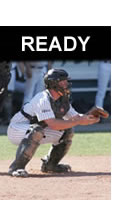Catchers: Tips, Drills, Information, Catching Equipment, Catchers Gear |
||||
Baseball-Catcher.com |
||||
Ready Catchers Stance |
||||
| Basic
Skills Stance Setting Up Receiving Framing Blocking Throwing Leadership In-depth Skills Relays, Cutoffs, and Plays at Home Signals Calling A Game Catching Bullpens Covering Bases Pre-Game Routine Umpire Rapport Misc. Situations and Plays |
 Slightly Stagger Your FeetOne area where I see bad information being passed along is foot alignment. Foot alignment is very important in a ready stance. Your feet should be SLIGHTLY staggered. DO NOT stagger your feet more than a few inches from parallel. Some coaches teach their players to "cheat" with their feet over staggered. This is BAD and here's why. The reason coaches teach their players to over stagger their feet is to help in throwing out runners attempting to steal. This may help them set their feet quicker but it takes away from the catcher's ability to block wild pitches. Lining up in an extremely staggered stance forces the hips and the shoulders to NOT BE SQUARE to the pitcher. It is much harder for a catcher to turn his body and successfully block a pitch in the dirt. It is even harder to block a pitch in the dirt to either side of the catcher. A runner attempting to steal is trying to EARN that base and a catcher still has a great shot at throwing out the runner without cheating with his feet. Almost all bases are stolen off the pitcher, not the catcher. A runner on base will benefit from a catcher who is out of position (staggered feet) and is unable to block a ball in the dirt. Make the offense earn the base and do not give it away by being out of position. GENERAL BASEBALL RULE: keys to winning baseball games - Making the opposing team earn bases and not giving away bases. IMPORTANT POINT: Keep your hips and shoulders square to the pitcher and slightly stagger your feet! Arm position and angle should be the same for both ready and relaxed stances. Arm position should be midway between a fully extended arm and a completely bent arm. The level of your elbow should still be below your mitt level.Throwing Hand Behind MittThe throwing hand in the ready stance is directly behind the mitt in a fist. The throwing hand should not be touching the mitt but very close to it. Your hand will be safe from foul tips in this position. Having your throwing hand behind the mitt and NOT behind your shoe facilitates a quicker transition of the ball from your mitt to your throwing hand. This serves mainly as a method of finding the proper grip on the ball, which aids in throwing out runners attempting to steal. Also, with your hand behind your mitt, it is easier and quicker to get into the proper blocking position, which will be discussed in a later section. KEYS: Ready Stance, Hips and Shoulders Square to Pitcher, Weight on Balls of Feet, Low Athletic Position, Arm Position, Palm Toward Pitcher, Target, Fist Behind Glove |
 OnBaseball.com | ||